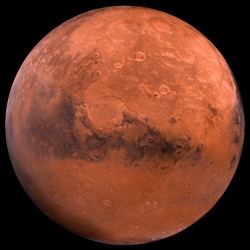
New images taken by the ESA’s Mars Express orbiter have provided a fresh look at a region believed to be hiding large volumes of water ice just beneath the surface, something that could serve as a water source for future manned missions to the Red Planet.
The area in question is an ancient Martian mountain range known as the Phlegra Montes, spanning some 1,400 km (870 miles) across the planet’s northern lowlands region. It’s thought to be the product of tectonic forces, which brought it into existence between 3.65 and 3.91 billion years ago.
The new images were captured by the High Resolution Stereo Camera on the Mars Express orbiter on October 8, 2014, focusing on the southern tip of the range. They detail features that add weight to the theory that glaciers once developed in the region, supporting the notion that ice may still reside there today, as little as 20 m (66 ft) below the surface.
Given its position in the mid-latitudes of Mars, you wouldn’t naturally expect to find glaciers in the region. However, it’s thought that the planet has experienced dramatically changing climatic conditions due to a historical variation in the tilt of its polar axis, explaining the strange position of the ancient ice.
